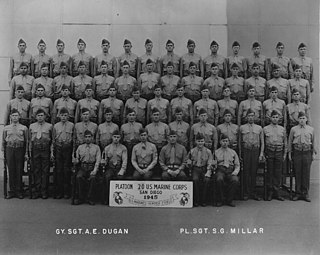
A platoon is a military unit typically composed of two or more squads, sections, or patrols. Platoon organization varies depending on the country and the branch, but a platoon can be composed of 50 people, although specific platoons may range from 10 to 100 people. A platoon is typically the smallest military unit led by a commissioned officer. The platoon leader is usually a junior officer—a second or first lieutenant or an equivalent rank. The officer is usually assisted by a platoon sergeant.

A grenade launcher is a weapon that fires a specially-designed large-caliber projectile, often with an explosive, smoke or gas warhead. Today, the term generally refers to a class of dedicated firearms firing unitary grenade cartridges. The most common type are man-portable, shoulder-fired weapons issued to individuals, although larger crew-served launchers are issued at higher levels of organisation by military forces.

The M4 carbine is a 5.56×45mm NATO, gas-operated, magazine-fed, carbine developed in the United States during the 1980s. It is a shortened version of the M16A2 assault rifle.

A mortar is usually a simple, lightweight, man-portable, muzzle-loaded weapon, consisting of a smooth-bore metal tube fixed to a base plate with a lightweight bipod mount and a sight. They launch explosive shells in high-arcing ballistic trajectories. Mortars are typically used as indirect fire weapons for close fire support with a variety of ammunition.

The M224 60 mm Lightweight Company Mortar System (LWCMS) is a smooth bore, muzzle-loading, high-angle-of-fire mortar used for close-in support of ground troops. It was deployed extensively in the War in Afghanistan by the United States military.
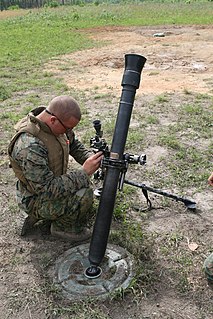
The M252 81 mm medium weight mortar is a British-designed smooth bore, muzzle-loading, high-angle-of-fire weapon used for long-range indirect fire support to light infantry, air assault, and airborne units across the entire front of a battalion zone of influence. In the U.S. Army and U.S. Marine Corps, it is normally deployed in the mortar platoon of an infantry battalion.

The M240 – officially the Machine Gun, 7.62 mm, M240 – is the U.S. military designation for the FN MAG, a family of belt-fed, gas-operated medium machine guns that chamber the 7.62×51mm NATO cartridge.

The Type 89 grenade discharger, inaccurately and colloquially known as a knee mortar by Allied forces, is a Japanese grenade launcher or light mortar that was widely used in the Pacific Theater of World War II. It got the nickname the "knee mortar" because of an erroneous Allied belief that these launchers could be fired by propping its plate against the leg. However, anyone trying to fire it this way would receive a severe bruise from its hefty recoil.

The brigade combat team (BCT) is the basic deployable unit of maneuver in the U.S. Army. A brigade combat team consists of one combat arms branch maneuver brigade, and its assigned support and fire units. A brigade is normally commanded by a colonel (O-6) although in some cases a brigadier general (O-7) may assume command. A brigade combat team contains combat support and combat service support units necessary to sustain its operations. BCTs contain organic artillery training and support, received from the parent division artillery (DIVARTY). There are three types of brigade combat teams: infantry, Stryker, and armored.

The M2 Mortar is a 60 millimeter smoothbore, muzzle-loading, high-angle-of-fire weapon used by U.S. forces in World War II, the Korean War, and the Vietnam War for light infantry support.

The XM395 Precision Guided Mortar Munition (PGMM) is a 120 mm guided mortar round developed by Alliant Techsystems.

The MO-120 RT or MO-120-RT is a French heavy mortar. The RT in the designator stands for rayé, tracté, which means rifled, towed. The MO-120-RT is currently used by the French Army, and has also been exported to more than 24 foreign countries or in some cases, produced under licence. It is issued to artillery units, where it complements artillery guns and systems; although infantry units operate it in some countries.

The Estonian Land Forces, unofficially referred to as the Estonian Army, is the name of the unified ground forces among the Estonian Defense Forces where it has an offensive military formation role. It is currently the largest Estonian military branch with the average size during peacetime of approximately 6,000 soldiers, conscripts, and officers.
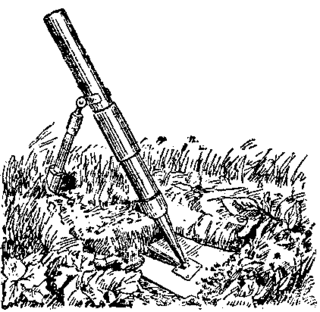
The 37mm spade mortar is a Soviet 37 mm light infantry mortar used in the Second World War. The mortar was produced from 1939 until the end of 1941.
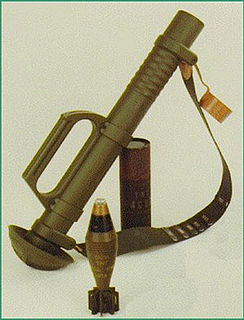
The term Commando mortar refers to a class of lightweight infantry mortars designed for maximum portability and rapid deployment with a caliber of 60mm or less in diameter, at the expense of accuracy and repeatability. Earliest models had been introduced from the 1930s onwards.

The M6 Mortar is a 60 mm lightweight infantry mortar made by Hirtenberger AG of Austria.
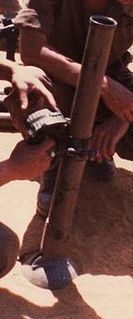
The M-4 Commando Mortar also known as a "patrol mortar" is a lightweight 60 mm commando mortar manufactured by Denel Land Systems.

















